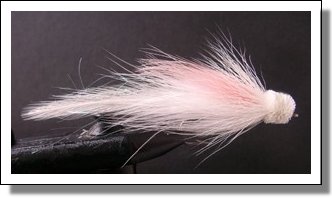
The Muddled Soft Hackle Deceiver is one of my favorite flies to use when striped bass are holding or feeding near the surface on small, slender baitfish such as silversides or sand eels. At these times its slimmer, sparser profile can make it more effective than similar but more robust patterns like the BeastMaster General. Tied with a deer hair head so that it sits in the surface film or sinks just a bit below, it's a good pattern to dead-drift or cast cross-current and swing into a group of feeding fish. The sparse tailwing and marabou hackle react enticingly to each movement of current. If you dress the head with floatant, the Muddled Soft Hackle Deceiver will also serve quite nicely as a surface pattern or as a "skitterer."
Tying the Muddled Soft Hackle Deceiver
The Muddled Soft Hackle Deceiver can be tied in a variety of lengths and colors, but the dressing below is my favorite for general use. Overall length of the fly should be between 3 and 3 1/2 inches.
While recently I've used the Muddled Soft Hackle Deceiver mainly for salt water striped bass, for many years I used it for fresh water trout and bass. If you want to tie a fresh water version, I recommend using a Daiichi 2451 (regular shank) 2141, or 2460 (long shank) hook.
|
Hook: |
M34011 (long shank), M#34007 (regular shank) or similar, sizes 2-6 |
|
Thread: |
3/0 monocord, white |
|
Tail Wing: |
White saddle or neck feathers, length to vary |
|
Tail Flash: |
Pearl Gartside's Secret Stuff or similar material |
|
Body: |
Pearl Glimmer or similar material |
|
Topping: |
Pink or chartreuse marabou or none |
Collar: |
White deer body hair |
Head: |
Trimmed white deer hair |
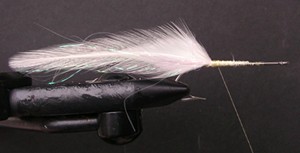 Match two thinnish saddle or neck feathers concave side to concave side and tie these in just forward of the bend of the hook. Trim excess. Tie in strands of GSS or similar material on both sides of tailwing.
Match two thinnish saddle or neck feathers concave side to concave side and tie these in just forward of the bend of the hook. Trim excess. Tie in strands of GSS or similar material on both sides of tailwing.
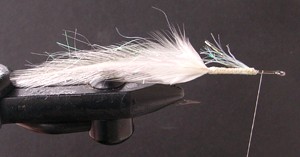 Tie in and wind on a body of Glimmer or similar material, leaving approximately 1/2 inch of space up near the eye for your deer hair head.
Tie in and wind on a body of Glimmer or similar material, leaving approximately 1/2 inch of space up near the eye for your deer hair head.
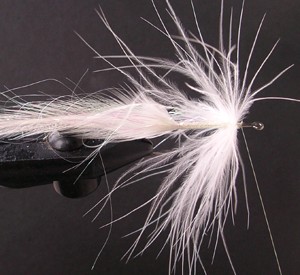 Choose a blood marabou feather whose hackles, when wound on, will extend to approximately the middle of the tailwing. Tie feather in at point where stem begins to taper sharply and trim off the excess butt portion of the feather. Take 3-4 turns of feather around the shank. Tie down feather and trim excess.
Choose a blood marabou feather whose hackles, when wound on, will extend to approximately the middle of the tailwing. Tie feather in at point where stem begins to taper sharply and trim off the excess butt portion of the feather. Take 3-4 turns of feather around the shank. Tie down feather and trim excess.
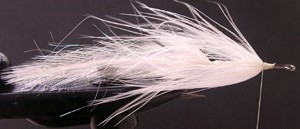 Moisten fingers slightly and sweep marabou fibers to the rear and wind your thread back over them a few turns to compact them slightly.
Moisten fingers slightly and sweep marabou fibers to the rear and wind your thread back over them a few turns to compact them slightly.
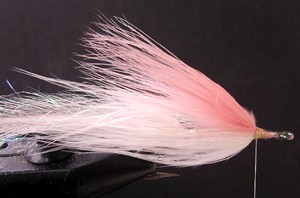 Tie in a topping of pink (or other color) marabou so that tips are just a bit shorter than the white marabou hackle. Trim excess.
Tie in a topping of pink (or other color) marabou so that tips are just a bit shorter than the white marabou hackle. Trim excess.
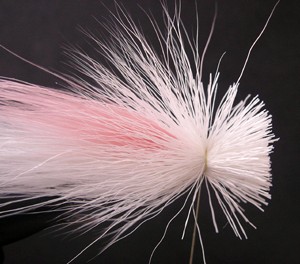 Tie in a deer body hair collar so that tips extend back over marabou 1-1 1/4 inch. Hairs should be evenly distributed around the shank.
Tie in a deer body hair collar so that tips extend back over marabou 1-1 1/4 inch. Hairs should be evenly distributed around the shank.
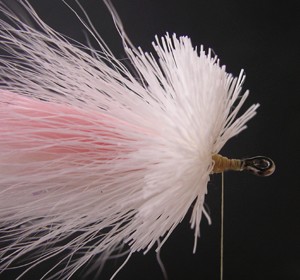 Push deer hair butts back away from the eye of the hook and take several turns of thread in front of them to hold them in position. These hairs will form the rear portion of your deer hair head.
Push deer hair butts back away from the eye of the hook and take several turns of thread in front of them to hold them in position. These hairs will form the rear portion of your deer hair head.
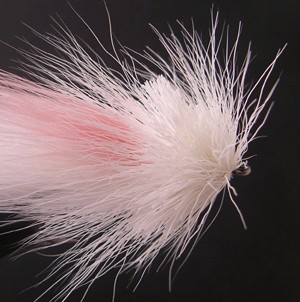 Tie in a clump of well-cleaned deer body hair and distribute hairs evenly with turns of thread around the shank of the hook, filling in all the space between the collar butts and the eye of the hook. (For a detailed description of this process, see my books, Scratching the Surface or Original Salt Water Fly Patterns). Tie off and whip-finish a small thread head and apply a drop or two of head cement to same.
Tie in a clump of well-cleaned deer body hair and distribute hairs evenly with turns of thread around the shank of the hook, filling in all the space between the collar butts and the eye of the hook. (For a detailed description of this process, see my books, Scratching the Surface or Original Salt Water Fly Patterns). Tie off and whip-finish a small thread head and apply a drop or two of head cement to same.
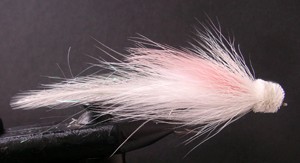 Trim hair to proportionate shape, taking care to not cut off the collar hairs.
Trim hair to proportionate shape, taking care to not cut off the collar hairs.






